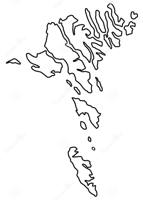
|
The Society of Folk Dance Historians (SFDH) Faroe Islands
[
Home |
About |
Encyclopedia | CLICK IMAGE TO ENLARGE |

|
BACKGROUND
Information: An archipelago.
The Faroe Islands, or simply Faroes, are a North Atlantic archipelago located 200 miles north-northwest of Scotland, and about halfway between Norway and Iceland. Like Greenland, it is an autonomous territory within the Kingdom of Denmark.
The terrain is rugged; the climate is subpolar oceanic climate: windy, wet, cloudy, and cool. Temperatures average above freezing throughout the year because of the Gulf Stream.
Between 1035 and 1814, the Faroe Islands were part of the Kingdom of Norway, which was in a personal union with Denmark from 1450. In 1814, the Treaty of Kiel transferred Norway to the King of Sweden, on the winning side of the Napoleonic Wars, whereas Denmark retained the Faroe Islands, along with Greenland and Iceland.
Although a rich spoken tradition survived, but for 300 years the language was not written down. This means that all poems and stories were handed down orally. These works were split into the following divisions: sagnir (historical), ævintýr (stories) and kvæði (ballads), often set to music and the medieval chain dance. These were eventually written down in the 19th century.
The traditional Faroese national dress is a local handicraft that people spend a lot of time, money, and effort to assemble. It is worn at weddings and traditional dancing events, and on feast days. The cultural significance of the garment should not be underestimated, both as an expression of local and national identity and a passing on and reinforcing of traditional skills that bind local communities together. Each piece is intricately hand-knitted, dyed, woven or embroidered to the specifications of the wearer. For example, the man's waistcoat is put together by hand in bright blue, red, or black fine wool. The front is then intricately embroidered with colourful silk threads, often by a female relative. The motifs are often local Faroese flowers or herbs. After this, a row of Faroese-made solid silver buttons are sewn on the outfit. Women wear embroidered silk, cotton, or wool shawls and pinafores that can take months to weave or embroider with local flora and fauna. They are also adorned with a handwoven black and red ankle-length skirt, knitted black and red jumper, a velvet belt, and black 18th century style shoes with silver buckles. The outfit is held together by a row of solid silver buttons, silver chains, and locally-made silver brooches and belt buckles, often fashioned with Viking style motifs.
National Dance: Faroese Ring Dances
Location: Northwest Europe
Language: Faroese, Danish
Religion: Christianity
DOCUMENTS
- Scandinavia, a region.
This page © 2018 by Ron Houston.
Please do not copy any part of this page without including this copyright notice.
Please do not copy small portions out of context.
Please do not copy large portions without permission from Ron Houston.